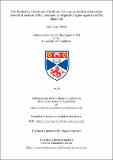Files in this item
The Kimberley Process and Certificate Scheme : a classical Aristotelian rhetorical analysis of the international tripartite regime against conflict diamonds
Item metadata
| dc.contributor.advisor | Roscoe, Philip | |
| dc.contributor.advisor | Vlcek, William | |
| dc.contributor.author | Davis, Lori Leigh | |
| dc.coverage.spatial | xx, 439 p. | en_US |
| dc.date.accessioned | 2018-06-19T13:03:52Z | |
| dc.date.available | 2018-06-19T13:03:52Z | |
| dc.date.issued | 2018-05-01 | |
| dc.identifier.uri | https://hdl.handle.net/10023/14255 | |
| dc.description.abstract | Established in 2003, the Kimberley Process (KP) is a binding agreement; backed by the United Nations, that unites civil societies, state actors and the diamond industry to safeguard ‘conflict’ diamonds from entering legitimate rough diamond trade around the world. The unique international tripartite organization is voluntary but mandates state participants to abide by the Kimberley Process Certification Scheme (KPCS) minimum requirements in order to stem the financing or wars against legitimate governments. This study represents the first to explore the communications within the KP. The linguistic turn relies on Classical rhetoric theory with an emphasis on Aristotle’s three appeals of persuasion (“pisteis”): ethos, logos and pathos of elite actors in the KP. As for the precise nature of the contribution to rhetorical analysis, this project is best characterised as an application of Classical principals of rhetorical analysis, rather than as a development of theory. A comprehensive literature review of the KP and KPCS is another distinctive contribution. Furthermore, this academic endeavour offers a unique method as shown in the observation of a KP Intersessional meeting. Supplementing the qualitative inquiry, semi-structured interviews were conducted with all of the KP groups and included a wide sample of civil society international and national non-government organizations, state actors and industry members otherwise not represented in previous empirical efforts on the subject. The data chapters achieve the primary aim to add to the understanding of the KP. Firstly, the civil societies engage in boycott rhetoric using ethos and negative pathos. As for state actors, the KP Chair exhibits charismatic leadership rhetoric, while ‘recognized’ established states use logical reasoning, the ‘outlier’ states evoke positive pathos. Lastly, the diamond industry experts appeal to negative emotions, the World Diamond Council to logos, and De Beers to positive emotional appeals. Combined, the rhetoric shows (a) how KP rhētors use different rhetorical strategies; (b) which in turn shape distinct discourses; (c) and contain dissimilar claims; (d) points to different motivations; (e) highlight different identities; (f) reveal key characteristics, and; (g) the nature of relationships within the KP. The organization rhetorical analysis also entails how the multiple KP leaders view the KP and KPCS and change. While the rhetoric helps demonstrate the constraints surrounding the KP and KPCS it also underlines the primary human rights and human security in which they all share. This thesis provides an extended critical view of the rhetoric by connecting Aristotelian pisteis with different conceptions of power outlined by French and Raven (1959) and Lukes (2005/1974). Combined, the rhetoric helps to explain the ways the KP attempts to achieve their specific political and economic goals while also building relationships with their stakeholders. Rhetoric is a worthwhile theory and methodological approach in order to explore organizations. The KP, and other international organizations provide an opportune arena for further rhetorical attention. | en_US |
| dc.language.iso | en | en_US |
| dc.publisher | University of St Andrews | |
| dc.rights | Attribution-NonCommercial-NoDerivatives 4.0 International | * |
| dc.rights.uri | http://creativecommons.org/licenses/by-nc-nd/4.0/ | * |
| dc.subject | The Kimberley Process/Kimberley Process Certificate | en_US |
| dc.subject | Conflict diamonds/blood diamonds | en_US |
| dc.subject | Aristotle rhetorical anaylsis | en_US |
| dc.subject | Ethos/logos/pathos | en_US |
| dc.subject | International tripartite regime | en_US |
| dc.subject | Organisational rhetoric | en_US |
| dc.subject | Steven Lukes Power | en_US |
| dc.subject | The diamond industry | en_US |
| dc.subject.lcc | HD9677.A2D2 | |
| dc.subject.lcsh | Diamond industry and trade | en |
| dc.subject.lcsh | Conflict diamonds | en |
| dc.subject.lcsh | Rhetorical criticism | en |
| dc.subject.lcsh | Rhetoric--Political aspects | en |
| dc.subject.lcsh | United Nations | en |
| dc.subject.lcsh | International cooperation | en |
| dc.title | The Kimberley Process and Certificate Scheme : a classical Aristotelian rhetorical analysis of the international tripartite regime against conflict diamonds | en_US |
| dc.type | Thesis | en_US |
| dc.type.qualificationlevel | Doctoral | en_US |
| dc.type.qualificationname | PhD Doctor of Philosophy | en_US |
| dc.publisher.institution | The University of St Andrews | en_US |
| dc.publisher.department | School of International Relations | en_US |
| dc.rights.embargoreason | Embargo period has ended, thesis made available in accordance with University regulations | en |
| dc.identifier.doi | https://doi.org/10.17630/10023-14255 |
The following licence files are associated with this item:
This item appears in the following Collection(s)
Except where otherwise noted within the work, this item's licence for re-use is described as Attribution-NonCommercial-NoDerivatives 4.0 International
Items in the St Andrews Research Repository are protected by copyright, with all rights reserved, unless otherwise indicated.


